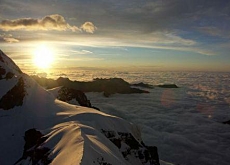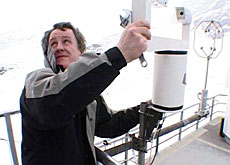Have children – will travel to high altitudes

More children than adults are prone to suffer from acute mountain sickness (AMS) or other health problems that can develop at high altitudes.
The acclimatisation study carried out by Zurich University at the top of the Jungfraujoch – 3,540 metres above sea level – was the first of its kind involving children.
A host of medical conditions can develop when you travel to altitudes above 2,500m.
AMS symptoms include headache, fatigue, excessive breathlessness caused by exertion, loss of appetite, nausea, vomiting and difficulty sleeping, due to irregular breathing and frequent arousals during sleep.
According to the medicine centre of the International Mountaineering and Climbing Federation, between 20 and 30 per cent of travellers develop some form of AMS at 3,500m and 50-60 per cent at 4550m.
Until now, very little has been known about the effects on children, even though they often travel above the critical level, holidaying in European and North American mountain resorts with their parents.
Guinea pigs
Chosen to spend three days as guinea pigs at the Jungfraujoch research station last summer were 20 adult men, each accompanied by a prepubescent son or daughter. Women were excluded because their menstrual cycle can interfere with the results.
“None of the children taking part in the study had ever been above 3,000m before,” Susi Kriemler, the paediatrician who led the study, told swissinfo.
“First of all, I wanted to see if there were any differences between children and adults and of secondary [importance], whether there is a hereditary influence on how they behave at altitude,” Kriemler explained.
The paediatrician measured pulmonary function, cardiac function, fluid balance, sleep and exercise performance, putting the participants through their paces on stationary bicycles and, on the second day, a mandatory outdoor hike.
“If adults do intense exercise, they increase the risk of getting sick,” she said.
Sick for science
Ten-year-old Isabelle Wolfensberger told swissinfo she was “sick for science”, vomiting on the first night and feeling weak all of the next day.
Father, Matthias Wolfensberger, did not report any adverse health effects beyond finding it harder to breath, and tiring more easily.
The 45-year-old engineering agronomist, Samuel Gerber, said he only suffered from an “unpleasant headache” the first night which got worse as the morning approached.
His 12-year-old son, Christoph, said he felt dizzy on the evening of arrival, and started to sweat, but added that the symptoms quickly disappeared after lying down for a short time.
Both father and son found themselves getting out of breath much more easily during the exercises.
Microscope
Nearly half a year after putting the participants under the high-altitude microscope, Kriemler has made some preliminary conclusions, albeit cautious ones, since they are based on the behaviour of such a small sample of test persons.
She said there was no great difference – statistically – in the symptoms suffered by the adults or children, even though half of the children got sick while only six of the grown-ups were ill.
Compared with their performance measured in Zurich, both groups performed less well on the bicycle and hike due to the rarefied air. Both saw a similar reduction in their performance and there was no difference between the fathers and their children when the amount of oxygen in their blood was measured during sleep.
However, Kriemler said the youngsters tended to breath more at altitude, seen as a positive sign, and were less prone to the respiratory condition which is common at altitude and known as “periodic breathing” during sleep, cycles of normal breathing, breath-holding, and accelerated breathing.
Any further conclusions or studies on the subject are unlikely to alter the main message for children or adults planning to spend time at altitude: take time to acclimatise.
“I’ve often been with my father in the mountains,” said the young Gerber. “My first thought when he asked me to take part was, ‘is there enough air up there’?”
swissinfo, Dale Bechtel
The trip to the Jungfraujoch in the Bernese Oberland is one of the most popular mountain railway excursions in the Alps.
A few hundred thousand people travel to the Jungfraujoch each year, going from a few hundred metres above sea level to about 3,500m and back again the same day.
They normally do not suffer adverse side effects due to the short duration at altitude.
The Jungfraujoch is also the site of a high altitude research station.
More extreme forms of AMS can occur at higher altitudes – above 4,000m:
High Altitude Pulmonary and Cerebral Oedema, in which fluid accumulates in the lungs, or more rarely in the brain, and causes severe illness.
The main advice for travelling to high altitudes is to gain height slowly – no more than 500m a day once above 2,500m – to acclimatise, and descend quickly if sickness develops.

In compliance with the JTI standards
More: SWI swissinfo.ch certified by the Journalism Trust Initiative



You can find an overview of ongoing debates with our journalists here. Please join us!
If you want to start a conversation about a topic raised in this article or want to report factual errors, email us at english@swissinfo.ch.